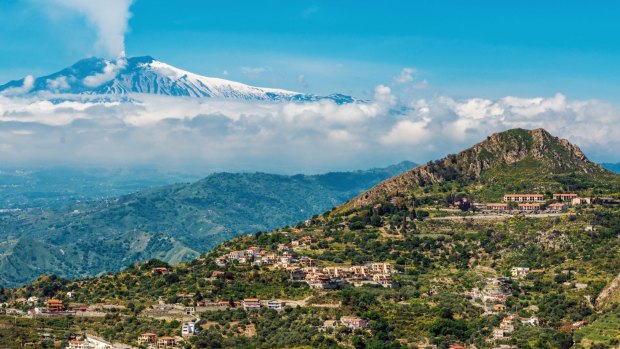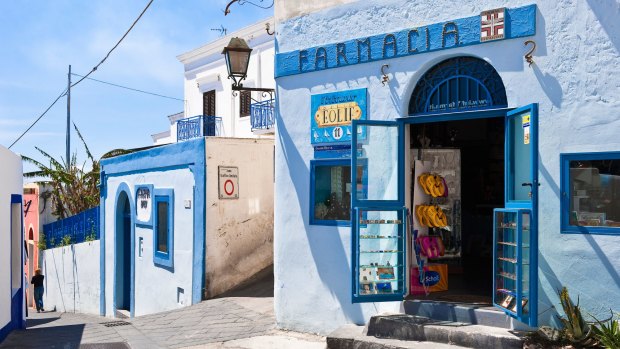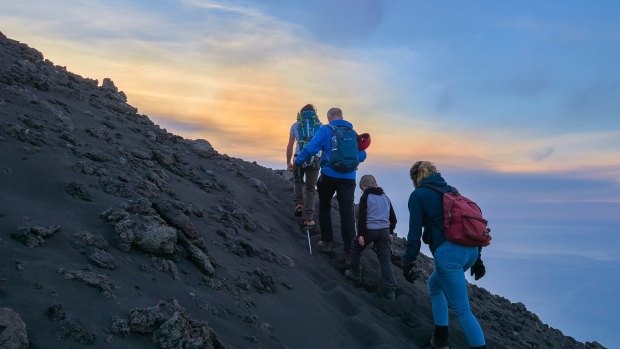This was published 4 years ago
Italy, Aeolian Islands and Sicily: Volcano visits to Stromboli and Mount Etna

A smoking Mount Etna, as seen from the scenic mountain town of Taormina.Credit: Shutterstock
I'm walking around the whitewashed streets of the eponymous village on Stromboli. This little settlement, on the remotest of the Aeolian Islands, looks like a Mediterranean dream, with streets so narrow only three-wheeled tuk tuks can navigate them. Backyards are filled with orange and lemon trees offering a colourful canopy for herb gardens below. When the breeze picks up, it carries with it scents of citrus and the sea. The whole place has a wonderful sense of relaxation to the point of narcolepsy – or at least it would if it weren't for a hideous industrial noise.
Before starting a trek to the centre of the island, I had discounted the idea that this noise could be coming from within – it sounded too close, too urgent. Still, I was well aware that Stromboli is Europe's most active volcano and the frequency of its eruptions prevents the forces within ever reaching their full apocalyptic potential.
In the first half an hour of the hike to the 924-metre summit with Magmatrek, our guide, Manuel, insists to our 20-strong group that, in fact, the rushing noise really is the volcano venting gas or lava, or both, out into the Mediterranean sky, day and night. While it's possible to try to catch a daytime glimpse, it's in every way superior after sunset. With that in mind, we set out at about 4pm, aiming to summit about three hours later during twilight

The whitewashed streets of the village on Stromboli, which looks like a Mediterranean dream.Credit: Alamy
This is considerably easier said than done. As we leave the village behind, the concrete path is replaced by dirt. We climb higher and higher along this plateau-free route, snaking between trees and shrubs, dutifully following Manuel and trying not to admit just how relentless we find the ascent.
After about 400 metres we stop, and so do the trees – the atmosphere is too hostile for them to grow, the ground too ashen. We catch our collective breath. From here, the Italian mainland is plainly visible, but not as clear as the islet of Strombolicchio, a near perfect cube of basalt rising out of the blue sea like a forgotten piece of volcanic Lego.
Manuel briefs us on what to expect, going into complicated detail about volcanology, which is best summed up when he says: "It's like, wow, ooh, oh my God – lucky you. And lucky me."

Hiking up the Stromboli volcano in the Aeolian islands, Sicily.Credit: Shutterstock
The young guide grew up on Stromboli, left to study on the Italian mainland but was inexorably drawn back to the volcano. Does it worry him, living on the side of such potential geological violence? "No," he insists, "the real dangers are in big cities."
We climb further up the black slopes of Stromboli, the volcanic venting growing louder all the time, from whisper to roar. As we crest the summit, the sun flits in and out of cloud, but there is much brighter light leaping from craters in front of us.
Officially there are two types of volcanic eruption but here there seems to be three. One sends fat, glowing globules of lava into the sky; another seems something like a burp, which is then followed by a menacing cloud of black gas. The noise I've been hearing all day comes from a third crater, which seems to erupt with a far greater fury than its fiery siblings, exploding straight up in an urgent column, something like the exhaust pipe from the Batmobile. As it screeches from the Earth, it also spews out little orange sparks that seem to hang in the sky, briefly joining stars that have started their own celestial show.
It's a lot to take in, but just before we settle down for an hour of this spectacle, Manuel uses the last of the dying light to point out something else. "There," he says, pointing south to the horizon. "Do you see it? That's Mount Etna."
Two days later, I am being picked up from the sensational Belmond Grand Hotel Timeo in Taormina on Sicily's east coast. The hotel has been here since the 1800s, a centrepiece of the town and credited with starting tourism on the island.
The reason for its longevity is obvious from its terrace – a yawning bay is fringed by hills and cliffs, making a pretty foreground for the volcanic behemoth on the horizon. At more than 3300 metres above sea level, Mount Etna is Europe's highest volcano. Just a few hundred metres shorter than the comparatively benign Mount Fuji, parts of it are also covered in snow year round.
On the hour-long drive from the Belmond, guide Lorenzo Motta tries to explain the enormousness of the mountain to me. More than 2 million people effectively live on its slopes and there are about 250 vineyards, making the most of its famously fertile soil.
"We always refer to Etna as female," says Lorenzo. "She is the mamma – she looks after us, provides us with so much, but sometimes she can also be angry."
The history of Etna's eruptions is writ large on her slopes, but the Ancients had their own explanations – the Greeks believed that Zeus trapped a deadly monster under the mountain. Most days there is smoke emitting from one or more of her craters, so much so that during my visit people are forbidden from approaching the summit, but once in a while she spews forth great rivers of lava. Lorenzo reassures me that even if this were to happen unexpectedly, Etna's lava moves so slowly that entire towns and villages can be evacuated before the sticky magma engulfs them.
The remnants of such eruptions are still visible on the slopes today, and some of these petrified deluges have themselves had to be bisected in order to reinstall roads. "These days we only have a few huts here on the north side," explains Lorenzo. "There's no ski-lift either – the last eruption destroyed it all and people didn't think they should rebuild. If you want those kinds of facilities, you need to go to the south side."
Being away from the more touristy section of the volcano affords us the chance to largely walk in peace, through snow and lava flows, past skeletal trees and along ridges forged by eruptions.
The contrasts between black and white remind me of those on Stromboli, where albino houses hug the black-sand shores of the island. "You can see it, I think," says Lorenzo, seeming to read my mind. "Look north from here," I follow his hand. "There, past that ridge." Just visible on the hazy horizon is little Stromboli, 100 kilometres away, belching away into the afternoon sky.
TRIP NOTES
MORE
FLY
Etihad flies to Catania, on Sicily, via Abu Dhabi and Rome from both Sydney and Melbourne. See etihad.com
STAY
Belmond Grand Hotel Timeo is arguably the best property on Sicily. Guests often split their clifftop stay here with the sister property, Belmond Villa Sant'Andrea, by the shore. Doubles from $535. See belmond.com
TOUR
Belmond Grand Hotel Timeo can arrange tours of Etna with Lorenzo Motta. See etnafinder.com
Jamie Lafferty was a guest of Belmond.
Sign up for the Traveller Deals newsletter
Get exclusive travel deals delivered straight to your inbox. Sign up now.